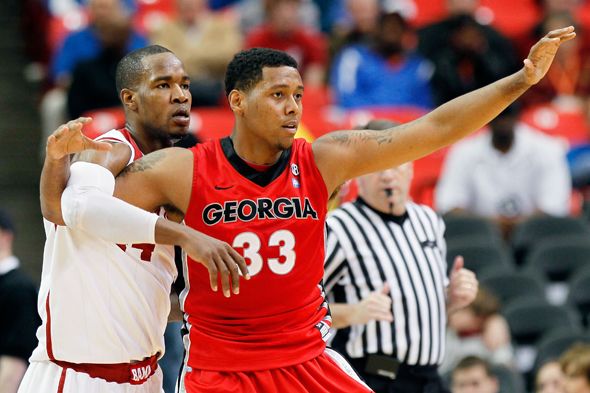
Washington will face a mix of monotony and menace when it tips-off Friday against Georgia in the second round of the NCAA Tourmanent.
The 10th-seeded Bulldogs out of the SEC want to deliver the ball inside whenever possible on offense. They have two mainstays, Trey Thompkins and Travis Leslie, to do it through. In addition, Georgia plays changing and skillful defense.
So, just what is Washington facing in the first round? Lets breakdown the Bulldogs.
Coach: Mark Fox
In his second season, Fox moved Georgia from 14-17 to 21-11 overall and 9-7 in the SEC. Fox previously coached at the University of Washington as a graduate assistant then a full-time assistant under Lynn Nance from 1991-93. From there, Fox was an assistant at Kansas State before taking over at Nevada, then moving on to Georgia.
Being part of Nances staff is not Foxs only tie to Washington. He is close friends with Washington head volleyball coach Jim McLaughlin. McLaughlin first met Fox when Fox was working on his masters of science in athletic administration and sports psychology at Kansas and McLaughlin was the head coach at Kansas State. From there, McLaughlin has maintained a form of mentoring relationship with him, often discussing the nuances of coaching and motivation. McLaughlin traveled to Georgia last year to speak with the Bulldogs coaching staff.
Likely starting five:
Dustin Ware: Ware is the Bulldogs primary shooter. He shoots 43.8 percent from behind the three-point line, a true percentage since he put up 128 attempts this season. He does little else. Ware is 5-11, 182 pounds. Expect Isaiah Thomas on him.
Gerald Robinson: A slasher who averages 12.2 points per game. The 6-1 junior will handle the ball a lot for the Bulldogs. He transferred from Tennessee State and his assist-to-turnover ratio is just 1.36-1. Expect C.J. Wilcox on Robinson to start the game.
Travis Leslie: Georgias third guard is a stout 6-4 and 205 pounds. He averages 14.5 points per game and is the Bulldogs best open court player. He rarely shoots three-pointers. He also rebounds well, averaging 7.2 per game. Justin Holiday will line up to defend Leslie.
Trey Thompkins: Georgias leading scorer (16.1 points per game) and rebounder (7.5) is a 6-10 junior. Thompkins actually had better numbers last season. Hes a skillful post player who does not get to the free throw line often. Washington will defend him with numerous players, likely considering double-teaming Thompkins once he dribbles the ball in the post. Matthew Bryan-Amaning will defend to start.
Jeremy Price: At 6-8, 270 pounds, hes the beef. Most of his hoops come because teams are paying attention to other parts of Georgias attack. He has trouble finishing near the rim. He averages 9.2 points and scored 20 or more three times this season. He should be countered by Aziz N’Diaye, assuming Washington goes big to start.
Georgia’s primary plays on offense
The weakside flex screen is at the core of what Georgia does on offense. The Bulldogs use this action over and over, primarily to get the stocky Leslie a good spot on the block. At 6-4, 205 pounds, Leslie is able to bully opposition there. How it works:
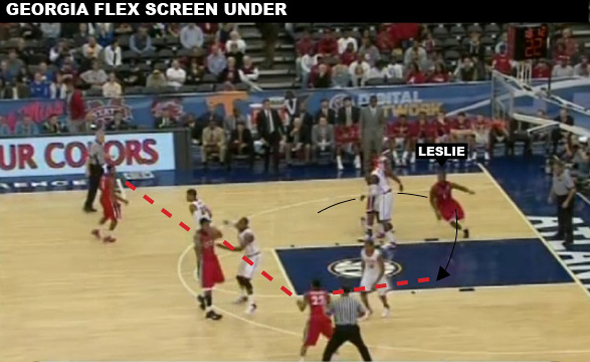
Georgia guard Ware starts with the ball high on the left side. After a small/big screen on the right side, versatile power forward Thompkins comes out to the three-point line. Ware swings the ball to Thompkins. Then Thompkins to Robinson, who previously set the screen for Thompkins, before drifting back out to the perimeter.
While the ball is swinging around the arc, 270-pound Georgia center Price is setting a pick for Leslie, who can choose to come underneath or over the top. Robinson is looking to enter the ball to Leslie in the post.
There, Leslie has multiple options depending the defenses reaction. Take his man one-on-one, pass over a double-team from the weakside big man to a waiting Price, kickout to Wade who is a good three-point shooter or reset. The movement is designed for Leslie to score swiftly.
Defenses with interchangeable parts, like Washington, can combat this action in multiple ways. Switch the screen, leaving someone like Justin Holiday with the screening big and Matthew Bryan-Amaning with Leslie in the post. Go over the top of the screen when Leslie goes under in order to front him and prevent the entry pass, though Georgia will try to lob over this because Leslie is an excellent leaper. Or simply fight through and play it straight. If Robinson is entering the ball, his defender can sag to make the pass more difficult and tempt Robinson into a three-point attempt, something he is not adept at.
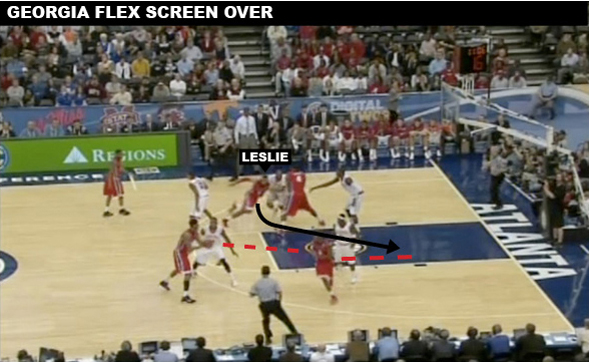
When, where and how often Leslie receives the ball from this action will be key.
Multi-screen post for Thompkins
Thompkins is Georgia’s best player. Hes a back-to-back All-SEC first-team selection. Georgia wants to post him whenever possible, though he will take the occasional three-pointer. How Georgia gets him prime position:
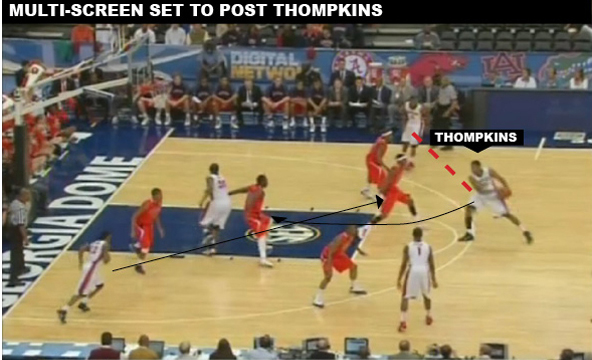
Leslie (No. 1) starts with the ball high on the left side. Robinson goes through to the lower left corner. After he goes by, Thompkins pops to the top of the key. Leslie swings the ball to Thompkins, who swings to Ware.
Robinson sprints out of the left corner to set a back screen for Thompkins who dives toward the rim. Once through, Robinson steps out to the top of the key to receive a pass back from Ware. While Robinson is out top, Thompkins is setting a back screen on the right side of the lane for fellow big man Price. Price cuts across the lane.
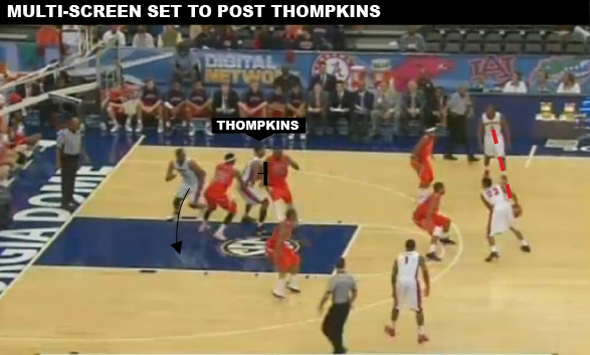
In the confusion, Thompkins sets his feet in the mid-block with one foot ideally in the lane. Robinson enters the ball to him.
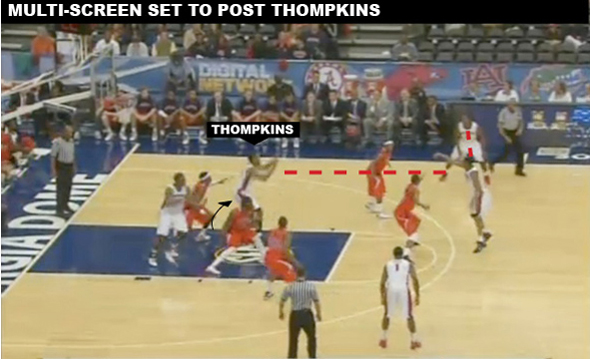
From here, Thompkins can go to the middle for his preferred jump hook. If the big guarding Price stays to double team, Thompkins can spin away from the double team to the baseline or try to get the ball to the unguarded Price. If a defender helps down off Ware, Thompkins can kick to him for a three-pointer.
Again, Washington can combat this in multiple ways. It can switch most of these screens, leaving Aziz NDiaye, Matthew Bryan-Amaning or Darnell Gant, who will likely be the best defense against Thompkins, to guard him. If the Huskies double Thompkins, the key will be backside help dropping down to Price. Leaving Leslie (31.7 percent, only 13 three-point makes all season) or Robinson (29.6 percent, 29 makes) open behind the three-point line is a good risk.
What Georgia does well: Defend, process offense. Romar said Georgia reminds him of USC defensively. Thats a large compliment. Georgia will mix defenses between a 2-3 zone and man-to-man. Their offensive philosophy of walking the ball up the court then setting a variety of screens to gain good post position reminds one of UCLA. But the Bruins have more options and talent than the Bulldogs have.
What Georgia does not do well: Create shots, shoot three-pointers. Also like the Bruins, Georgia will shift into an on-ball screen when one of its plays is snuffed out. After that, the Bulldogs are forced to freelance, usually late in the shot clock, an option that does not serve them well. Take away their best three-point shooter, Ware, and Georgia shoots just 30.1 percent as a team from behind the three-point line.
How Washington wins: Speed up the game, pressure the ball defensively. Again, hate to provide a thumping to the woebegone horse, but Georgia is akin to UCLA in that the Bulldogs have a three-step offensive process: Sets, on-ball screen, create. Washington will try to disrupt this the way it always does, by pressuring the ball handler. This may mean a single man picking up deep in the backcourt just to run the shot clock down. Trapping is likely. Both Georgia guards, particularly Robinson, are mediocre ball-handlers. At times, Georgia uses the 6-10 Thompkins to bring the ball up against pressure. Thats gravy to Washington. If a steal doesnt come, Georgia will be caught too deep in the shot clock to run good sets. That leads to harried shots, rebounds and run outs. Just what Washington wants.
How Georgia wins: By controlling pace with defense. This is what Georgia does very well. Defend, secure, walk. This allows them to setup plays, which it executes well. Georgia wants to pound inside as much as possible. Just 25 percent of its field-goal attempts this year were three-pointers. Compare that to 37 percent for Washington. The Bulldogs arent afraid to play a game in the 70s, but they get there through efficiency, not speed.
Prediction: Expect the Huskies depth and versatility to cause vast exposure to Georgias weaknesses. Washington should be able to create turnovers with its pressure. Too many layers to the Huskies, not enough to Georgia. Washington 83, Georgia 71.

5 Comments
Todd, very nice analysis of the matchup. I think an additional note that should be made is the Huskies ability to zone that could create problems for Thompkins to get easy buckets. Howland and UCLA had a great zone put together that forced UW to win by our shooting percentage. Thankfully we shot well. I’d like to think that we can overload the post and put pressure on the Bulldogs much like UCLA did with us. By showing them different looks I expect that we will create turnovers in transition or by aggressively disrupting their rhythm. Looking forward to the game!
This is a great analysis! I wish more people broke down the flex and other offenses like this. This makes the game so much more entertaining to watch when you know it. Keep up the good work!
Nice job, very informative.